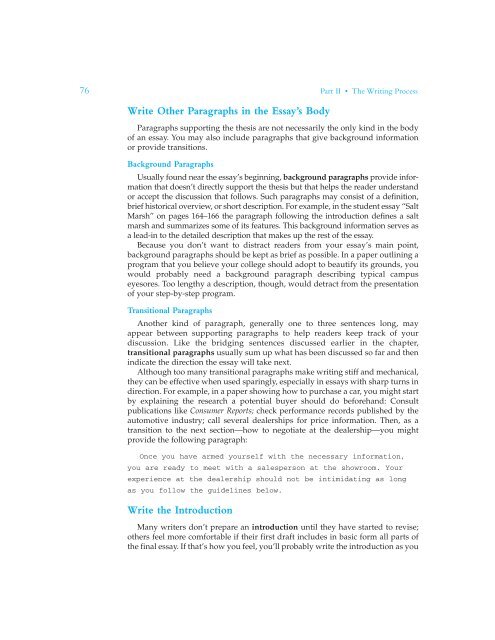writing the paragraphs in the first draft - Pearson Learning Solutions
writing the paragraphs in the first draft - Pearson Learning Solutions
writing the paragraphs in the first draft - Pearson Learning Solutions
Create successful ePaper yourself
Turn your PDF publications into a flip-book with our unique Google optimized e-Paper software.
76<br />
Part II • The Writ<strong>in</strong>g Process<br />
Write O<strong>the</strong>r Paragraphs <strong>in</strong> <strong>the</strong> Essay’s Body<br />
Paragraphs support<strong>in</strong>g <strong>the</strong> <strong>the</strong>sis are not necessarily <strong>the</strong> only k<strong>in</strong>d <strong>in</strong> <strong>the</strong> body<br />
of an essay. You may also <strong>in</strong>clude <strong>paragraphs</strong> that give background <strong>in</strong>formation<br />
or provide transitions.<br />
Background Paragraphs<br />
Usually found near <strong>the</strong> essay’s beg<strong>in</strong>n<strong>in</strong>g, background <strong>paragraphs</strong> provide <strong>in</strong>formation<br />
that doesn’t directly support <strong>the</strong> <strong>the</strong>sis but that helps <strong>the</strong> reader understand<br />
or accept <strong>the</strong> discussion that follows. Such <strong>paragraphs</strong> may consist of a def<strong>in</strong>ition,<br />
brief historical overview, or short description. For example, <strong>in</strong> <strong>the</strong> student essay “Salt<br />
Marsh” on pages 164–166 <strong>the</strong> paragraph follow<strong>in</strong>g <strong>the</strong> <strong>in</strong>troduction def<strong>in</strong>es a salt<br />
marsh and summarizes some of its features. This background <strong>in</strong>formation serves as<br />
a lead-<strong>in</strong> to <strong>the</strong> detailed description that makes up <strong>the</strong> rest of <strong>the</strong> essay.<br />
Because you don’t want to distract readers from your essay’s ma<strong>in</strong> po<strong>in</strong>t,<br />
background <strong>paragraphs</strong> should be kept as brief as possible. In a paper outl<strong>in</strong><strong>in</strong>g a<br />
program that you believe your college should adopt to beautify its grounds, you<br />
would probably need a background paragraph describ<strong>in</strong>g typical campus<br />
eyesores. Too lengthy a description, though, would detract from <strong>the</strong> presentation<br />
of your step-by-step program.<br />
Transitional Paragraphs<br />
Ano<strong>the</strong>r k<strong>in</strong>d of paragraph, generally one to three sentences long, may<br />
appear between support<strong>in</strong>g <strong>paragraphs</strong> to help readers keep track of your<br />
discussion. Like <strong>the</strong> bridg<strong>in</strong>g sentences discussed earlier <strong>in</strong> <strong>the</strong> chapter,<br />
transitional <strong>paragraphs</strong> usually sum up what has been discussed so far and <strong>the</strong>n<br />
<strong>in</strong>dicate <strong>the</strong> direction <strong>the</strong> essay will take next.<br />
Although too many transitional <strong>paragraphs</strong> make <strong>writ<strong>in</strong>g</strong> stiff and mechanical,<br />
<strong>the</strong>y can be effective when used spar<strong>in</strong>gly, especially <strong>in</strong> essays with sharp turns <strong>in</strong><br />
direction. For example, <strong>in</strong> a paper show<strong>in</strong>g how to purchase a car, you might start<br />
by expla<strong>in</strong><strong>in</strong>g <strong>the</strong> research a potential buyer should do beforehand: Consult<br />
publications like Consumer Reports; check performance records published by <strong>the</strong><br />
automotive <strong>in</strong>dustry; call several dealerships for price <strong>in</strong>formation. Then, as a<br />
transition to <strong>the</strong> next section—how to negotiate at <strong>the</strong> dealership—you might<br />
provide <strong>the</strong> follow<strong>in</strong>g paragraph:<br />
Once you have armed yourself with <strong>the</strong> necessary <strong>in</strong>formation,<br />
you are ready to meet with a salesperson at <strong>the</strong> showroom. Your<br />
experience at <strong>the</strong> dealership should not be <strong>in</strong>timidat<strong>in</strong>g as long<br />
as you follow <strong>the</strong> guidel<strong>in</strong>es below.<br />
Write <strong>the</strong> Introduction<br />
Many writers don’t prepare an <strong>in</strong>troduction until <strong>the</strong>y have started to revise;<br />
o<strong>the</strong>rs feel more comfortable if <strong>the</strong>ir <strong>first</strong> <strong>draft</strong> <strong>in</strong>cludes <strong>in</strong> basic form all parts of<br />
<strong>the</strong> f<strong>in</strong>al essay. If that’s how you feel, you’ll probably write <strong>the</strong> <strong>in</strong>troduction as you

















